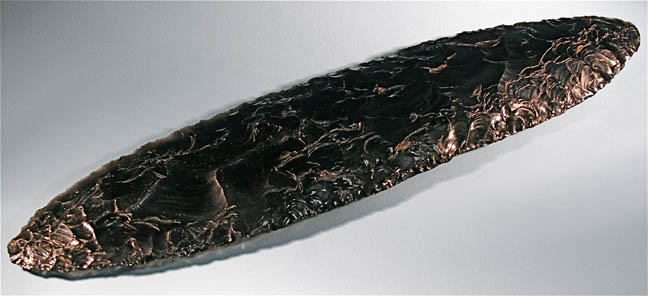

Title: A rare and very large Obsidian stone artifact spearhead
Shipping: $49.00
Artist: N/A
Period: Antiquity
History: N/A
Origin: North America > United States
Condition: Museum Quality
Item Date: 1000 to 3000
Item ID: 3603
Extremely Rare, One-of-a-Kind Large Obsidian Spearhead — Native American Artifact. This exceptional and very large obsidian spearhead is a one-of-a-kind artifact, expertly crafted by a master flintknapper. Spearheads of this size and material rarely survive due to the fragile nature of volcanic glass, which is prone to breaking. Very few examples this large are known to exist. Believed to have originated from the Yosemite Valley region, this piece comes from an old private San Francisco estate. The late collector, who lived to an advanced age, assembled an extraordinary collection of Native American artifacts—many considered museum-quality. Several subject experts have evaluated this artifact and unanimously agree that it is authentic. It could easily serve as a centerpiece in any premier Native American collection. Measurements: Length: 11 1/2 inches / Width: 2 5/8 inches / Artifacts of this caliber are rarely seen outside of museums and are highly sought after by serious collectors.This remarkable spearhead is made of deep black obsidian, featuring fine serrated edges and double-sided notching. When held to the light, the translucent edges reveal the skill and precision of its maker. Both beautiful and functional, such spearheads were traditionally used for hunting and warfare. While its exact age is unknown, it is believed to date as far back as the Early Bronze Age. This piece stands as a stunning display item and an important archaeological relic. Archaeology, a branch of anthropology, involves the study of human history through material remains—and this spearhead is a prime example of that enduring legacy. An absolutely gorgeous and rare addition to any serious collection. An 11.5-inch, finely serrated, double-notched obsidian spearhead of museum quality, evaluated by subject experts, and believed to be ceremonial in nature—its estimated market value could range from $5,000 to $15,000 or more. Prices on the high end are typically realized when: The item is verified with strong provenance. It is presented as ceremonial or rare due to its size and craftsmanship. There is a known cultural or regional link, such as confirmed origin from the Yosemite Valley and associated tribe (e.g., Miwok or Paiute) For insurance or formal appraisal purposes, I recommend having the spearhead reviewed by a credentialed appraiser specializing in Native American artifacts or presenting it to a museum with a tribal liaison. Busacca Gallery can recommend a subject expert related to this Artifact
Native American obsidian spearheads from California hold significant historical and cultural value, especially those originating from regions like the Yosemite Valley, where indigenous tribes skillfully crafted tools and weapons from the area's abundant volcanic glass. Obsidian was prized for its sharpness, workability, and striking appearance, making it an essential material for hunting and ceremonial objects. These spearheads not only reflect the advanced flintknapping techniques of Native American artisans but also serve as tangible links to tribal traditions, survival, and craftsmanship. In today’s market, authentic obsidian spearheads—particularly large, well-preserved, and expertly crafted examples—are highly collectible. Serious collectors and institutions alike seek them for their rarity, beauty, and historical significance, with museum-quality pieces commanding strong interest and high value.
Link: http://en.wikipedia.org/wiki/Spear
A spear is a pole weapon consisting of a shaft, usually of wood, with a sharpened head. The head may be simply the sharpened end of the shaft itself, as is the case with bamboo spears, or it may be of another material fastened to the shaft, such as obsidian, iron, or bronze. The most common design is of a metal spearhead, shaped like a triangle or a leaf.
Archeological evidence documents that wooden spears were used for hunting at least 400,000 years ago.
Neanderthals were constructing stone spear heads from as early as 300,000 BP. By 250,000 years ago wooden spears were made with fire-hardened points. From 200,000 BP Middle Paleolithic humans began to make complex stone blades which were used as spear heads. At these times there was still a clear difference between spears designed to be thrown and those designed to be used in hand to hand combat. By the Magdalenian period (c. 15000-9500 BCE), spear-throwers similar to the later atlatl were in use
Spears were one of the most common personal weapons from the Stone Age until the advent of firearms. They may be seen as the ancestor of such weapons as the lance, the halberd, the naginata, the bill and the pike. One of the earliest weapons fashioned by human beings and their ancestors, it is still used for hunting and fishing, and its influences can still be seen in contemporary military arsenals as the rifle-mounted bayonet.
Spears can be used as both ballistic and melee weapons. Spears used primarily for thrusting may be used with either one or two hands and tend to have heavier and sturdier designs than those intended exclusively for throwing. Those designed for throwing, often referred to as javelins, tend to be lighter and have a more streamlined head, and can be thrown either by hand or with the assistance of a spear thrower such as the atalatl or woomera. Out of the atlatl dart eventually the arrow for use with bows developed.